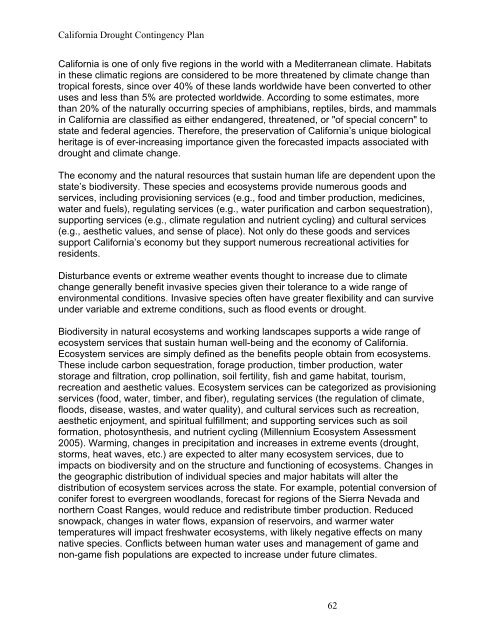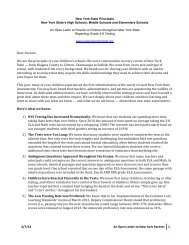Final_CA_Drought_Contingency_Plan-11-18-2010a
Final_CA_Drought_Contingency_Plan-11-18-2010a
Final_CA_Drought_Contingency_Plan-11-18-2010a
Create successful ePaper yourself
Turn your PDF publications into a flip-book with our unique Google optimized e-Paper software.
California <strong>Drought</strong> <strong>Contingency</strong> <strong>Plan</strong>California is one of only five regions in the world with a Mediterranean climate. Habitatsin these climatic regions are considered to be more threatened by climate change thantropical forests, since over 40% of these lands worldwide have been converted to otheruses and less than 5% are protected worldwide. According to some estimates, morethan 20% of the naturally occurring species of amphibians, reptiles, birds, and mammalsin California are classified as either endangered, threatened, or "of special concern" tostate and federal agencies. Therefore, the preservation of California’s unique biologicalheritage is of ever-increasing importance given the forecasted impacts associated withdrought and climate change.The economy and the natural resources that sustain human life are dependent upon thestate’s biodiversity. These species and ecosystems provide numerous goods andservices, including provisioning services (e.g., food and timber production, medicines,water and fuels), regulating services (e.g., water purification and carbon sequestration),supporting services (e.g., climate regulation and nutrient cycling) and cultural services(e.g., aesthetic values, and sense of place). Not only do these goods and servicessupport California’s economy but they support numerous recreational activities forresidents.Disturbance events or extreme weather events thought to increase due to climatechange generally benefit invasive species given their tolerance to a wide range ofenvironmental conditions. Invasive species often have greater flexibility and can surviveunder variable and extreme conditions, such as flood events or drought.Biodiversity in natural ecosystems and working landscapes supports a wide range ofecosystem services that sustain human well-being and the economy of California.Ecosystem services are simply defined as the benefits people obtain from ecosystems.These include carbon sequestration, forage production, timber production, waterstorage and filtration, crop pollination, soil fertility, fish and game habitat, tourism,recreation and aesthetic values. Ecosystem services can be categorized as provisioningservices (food, water, timber, and fiber), regulating services (the regulation of climate,floods, disease, wastes, and water quality), and cultural services such as recreation,aesthetic enjoyment, and spiritual fulfillment; and supporting services such as soilformation, photosynthesis, and nutrient cycling (Millennium Ecosystem Assessment2005). Warming, changes in precipitation and increases in extreme events (drought,storms, heat waves, etc.) are expected to alter many ecosystem services, due toimpacts on biodiversity and on the structure and functioning of ecosystems. Changes inthe geographic distribution of individual species and major habitats will alter thedistribution of ecosystem services across the state. For example, potential conversion ofconifer forest to evergreen woodlands, forecast for regions of the Sierra Nevada andnorthern Coast Ranges, would reduce and redistribute timber production. Reducedsnowpack, changes in water flows, expansion of reservoirs, and warmer watertemperatures will impact freshwater ecosystems, with likely negative effects on manynative species. Conflicts between human water uses and management of game andnon-game fish populations are expected to increase under future climates.62






